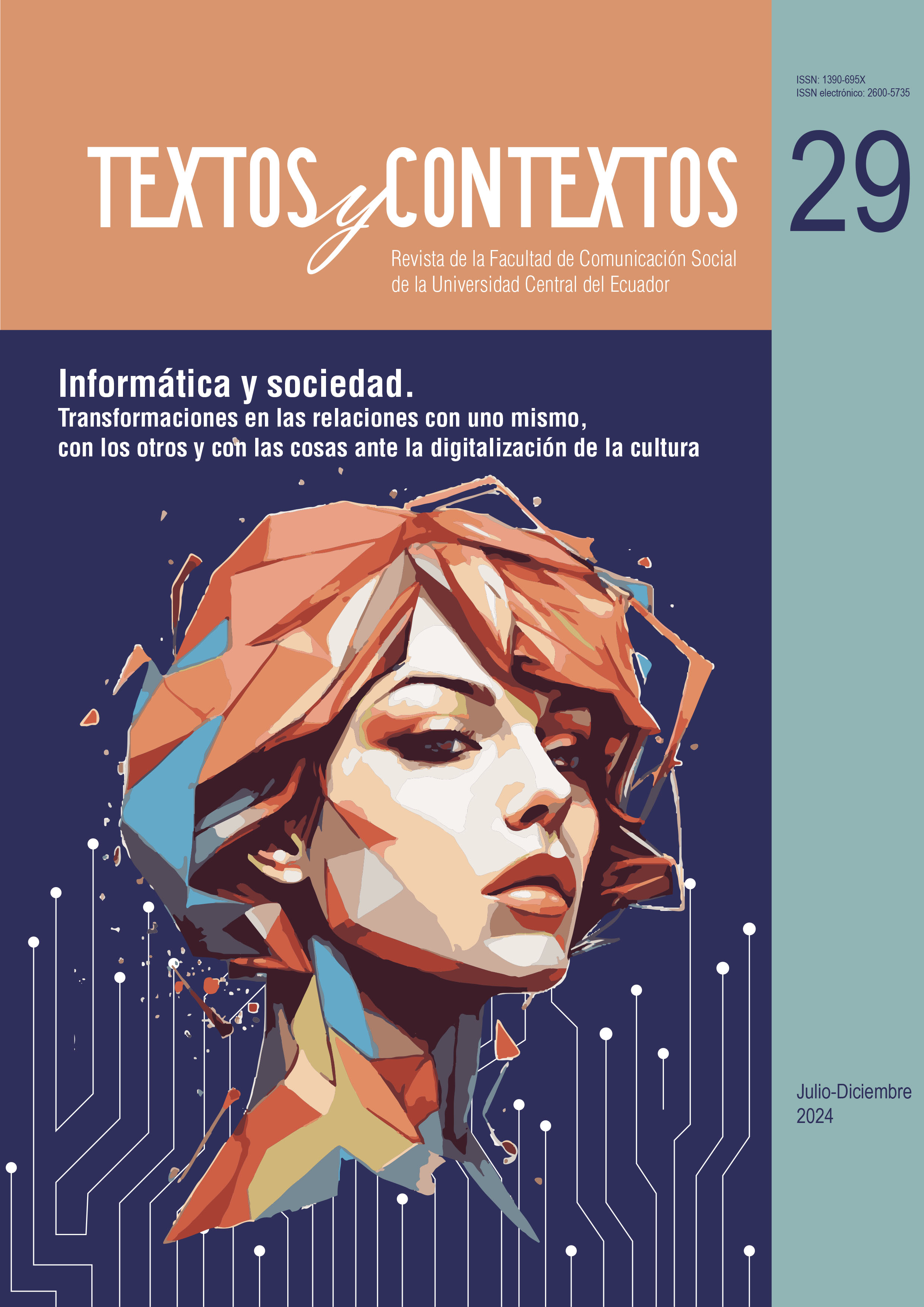Extimacy according to psychoanalysis. Other possible readings on the exhibition of intimacy on social media
Main Article Content
Abstract
The concept of extimacy is widely used in social sciences to refer to the practices of displaying intimacy, a phenomenon that arose at the beginning of the 21st century with the arrival of digital media, the Internet and social media. Notably, in the middle of the 20th century, psychoanalysis coined the same term, not to refer to a specific historical phenomenon but to a specific quality of the psychic constitution. The psychoanalytic conception of extimacy differs considerably from that used in social sciences: in this case, it is not an antonym of intimacy but a neologism that designates the external origin of the most intimate of the subject. This perspective forces us to think about the interior/exterior and private/public pairs beyond their dichotomy, underlines the constitutive relationship that the subject has with the other, and fundamentally, places the self-image in a central place in the foundation of the self. The objective of this essay is to present the concept of extimacy as understood by psychoanalysis, to show that it is a tool with great analytical power to address contemporary digital practices.
Downloads
Metrics
Article Details

This work is licensed under a Creative Commons Attribution-NonCommercial 4.0 International License.
References
Auglanier, P. (1977). La violencia de la interpretación. Amorrortu.
Berardi, F. (2017). Fenomenología del fin. Sensibilidad y mutación conectiva. Caja Negra.
Calzetta, J. J. (2011). Producción de subjetividad y constitución psíquica: lo que permanece y lo que cambia a través de la historia. Revista Universitaria de Psicoanálisis, 11, 43-55. http://www.bivipsi.org/wp-content/uploads/RUP_2011-3.pdf
Castoriadis, C. (2002). Las raíces psíquicas y sociales del odio. En AAVV, Guerra y muerte. Editorial FICA. (pp. 65-88).
Debord, G. (1995). La sociedad del espectáculo. Editorial La marca.
Eckel, J., Ruchatz, J., & Wirth, S. (2018) Exploring the Selfie. Historical, Theoretical, and Analytical Approaches to Digital Self-Photography. Palgrave Macmillan. DOI: https://doi.org/10.1007/978-3-319-57949-8
Fontcuberta, J. (2016). La furia de las imágenes: Notas sobre la postfotografía. Galaxia Gutemberg.
Freud, S. (2010a) Proyecto de psicología (1985). En Strachey, J. (Ed.) Obras Completas, Vol. I. Amorrortu, pp. 323-446.
Freud, S. (2010b) Psicología de las masas y análisis del yo (1921). En Strachey, J. (Ed.) Obras Completas, Vol. XVIII. Amorrortu, pp. 63-136.
Freud, S. (2010c) Tres ensayos de teoría sexual (1905). En Strachey, J. (Ed.) Obras Completas, Vol. VII. Amorrortu, pp. 109-224.
García-Arroyo, J. M. (2022). El estadio del espejo: antecedentes y fenomenología. Revista de la Asociación Española de Neuropsiquiatría, 42(142), pp.29-47. https://dx.doi.org/10.4321/s0211-57352022000200003 DOI: https://doi.org/10.4321/s0211-57352022000200003
Groys, B. (2014). Volverse público: las transformaciones del arte en el ágora contemporánea. Caja Negra. DOI: https://doi.org/10.12795/astragalo.2015.i20.15
Groys, B. (2023) Devenir otra de arte. Caja Negra.
Han, B. C. (2015). La agonía del Eros. Herder. DOI: https://doi.org/10.2307/j.ctvt9k1sh
Han, B. C. (2021). No Cosas. Quiebras del mundo de hoy. Taurus.
Izcovich, L. (2015). Sobre la identificación y la alienación. Desde el Jardín de Freud 15, pp. 81-90. DOI: 10.15446/dfj.n15.50489 DOI: https://doi.org/10.15446/dfj.n15.50489
Kenaan, H. (2018). The Selfie And The Face. En Eckel, J., Ruchatz, J., & Wirth, S.(eds) Exploring the Selfie. Historical, Theoretical, and Analytical Approaches to Digital Self-Photography. (pp. 113-130). Palgrave Macmillan. DOI: https://doi.org/10.1007/978-3-319-57949-8_6
Lacan, J. (1985) El mito individual del neurótico (1953). En Intervenciones y textos I. Manantial (pp.37-59)
Lacan, J. (1988). Breve discurso en la O.R.F.T. (1966). En Intervenciones y textos II. Manantial. (pp. 35-42)
Lacan, J. (2011a) El estadio del espejo como formador de la función del yo [je] tal como se nos revela en la experiencia psicoanalítica. (1949). En Escritos 1. Siglo XXI. (pp. 99-106)
Lacan, J., (2011b). Acerca de la causalidad psíquica (1946). En Escritos 1. Siglo XXI. (pp. 151-192)
Lacan, J. (2011c) Función y campo de la palabra y del lenguaje en psicoanálisis (1953). En Escritos 1. Siglo XXI. (pp. 231-310)
Laplanche, J. y Pontalis, J. (2006). Diccionario de Psicoanálisis. Paidós
Marwick, A. E. (2015). Instafame: Luxury selfies in the attention economy. Public culture, 27 (75). pp. 137-160. https://doi.org/10.1215/08992363-2798379 DOI: https://doi.org/10.1215/08992363-2798379
Mazzuca, R, Bleynat, H., Mazzuca, S., Ayerza, R., Calzado, A., Donatello, I; Greiner, G., Sánchez, J., Smejkal, O. y Tendlarz, E. (2005). La identificación en el primer Lacan. XII Jornadas de Investigación y Primer Encuentro de Investigadores en Psicología del Mercosur. Universidad de Buenos Aires. Recuperado de: https://www.aacademica.org/000-051/374.pdf
Meygide de Schargorodsky, R. (2024) Intimidad reconfigurada. En Sahovaler, J. (comp) Psicoanálisis, entre lo analógico y lo digital. APA Editorial. (pp. 47-64)
Miller, J.A. (2010) Extimidad. Los cursos psicoanalíticos de Jacques-Alain Miller. Paidós.
Pérez, X. (2023, 10 de mayo). La tendencia del autorretrato. ¿Qué dice la ciencia sobre el fenómeno imparable de la selfie? Agencia de Noticias Científicas. Recuperado de: https://agencia.unq.edu.ar/?p=12159
Puelles Romero, L. (1999). Interiores del alma. Lo íntimo como categoría estética. Thémata, 22, 241-247.
Quintana, A. (2003). Fábulas de lo visible, el cine como creador de realidades. Acantilado.
Sadin, É. (2017). La humanidad aumentada: la administración digital del mundo. Caja negra.
Sahovaler de Litvinoff, D. (2016) El sujeto escondido en la realidad virtual. Letra Viva.
Sandbye, M. (2018). Selfies and Purikura as Affective, Aesthetic Labor. En Eckel, J., Ruchatz, J. & Wirth, S. (eds). Exploring the Selfie. Historical, Theoretical, and Analytical Approaches to Digital Self-Photography. Palgrave Macmillan. pp. 305-326. DOI: https://doi.org/10.1007/978-3-319-57949-8_14
Sibilia, P. (2008). La intimidad como espectáculo. Fondo de Cultura Económica.
Tifentale, A. (2018). The Selfie: More and Less than a Self-Portrait. En: Moritz & Neumüller (Eds) Routledge Companion to Photography and Visual Culture. Routledge. pp. 44–58
Türcke, Ch. (1995). La sociedad de la sensación. Humboldt n° 115, Año 37, pp.10-13.
Van Dijck, J., Poell, T., & De Waal, M. (2018). The platform society: Public values in a connective world. Oxford University Press. DOI: https://doi.org/10.1093/oso/9780190889760.001.0001
Viñal, C. (2020). Ese íntimo desconocido. Ética y Cine Journal, 10(3), 13-18. https://doi.org/10.31056/2250.5415.v10.n3.30880 DOI: https://doi.org/10.31056/2250.5415.v10.n3.30880
Wajcman, G. (2011). El ojo absoluto. Manantial.




